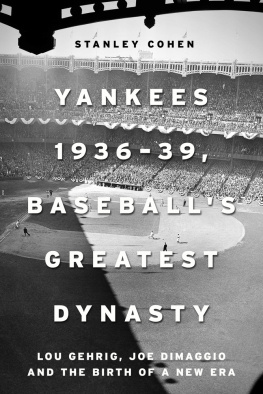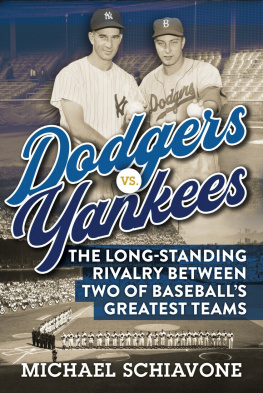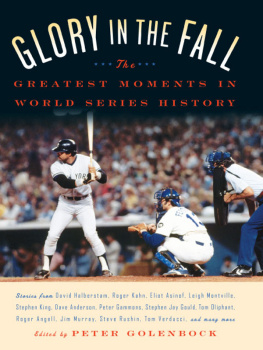DYNASTY
The New York Yankees 1949-1964
DYNASTY
The New York Yankees 1949-1964
by
PETER GOLENBOCK

copyright 1975 by Peter Golenbock
First Summer Game Books Edition 2014 at Smashwords
All rights reserved.
No part of this publication may be reproduced, stored in a retrieval system, or transmitted in any form by any process electronic, mechanical, photocopying, recording, or otherwise without prior written permission from the copyright owner and the publisher. The scanning, uploading, and distribution of this book via the internet or any other means without the permission of the publisher is illegal.
This book was originally published by
Prentice-Hall, Inc., Englwood Cliffs, NJ
ISBN: 978-1-938545-39-9 (ebook)
For information about permission, bulk purchases, or additional distribution,
write to Summer Game Books
P. O. Box 818
South Orange, NJ 07079
or contact the publisher at
www.summergamebooks.com
To my wonderful family. Mom and Dad and Rob and Wen, inspirations all; and to Puppa, wherever you and your magical dreams may be.
CONTENTS
During the 1920s New York Yankee owner Jacob Ruppert once described his idea of a perfect afternoon at Yankee Stadium. It's when the Yankees score eight runs in the first inning, Ruppert said, and then slowly pull away.
For millions of Yankee fans since the 1920s such a game was likewise their perfect afternoon. From my earliest remembrances in the early 1950s to 1964, it was mine as well. In the sixteen-season span from 1949 to 1964 the New York Yankees won fourteen pennants, a victorious dynasty unparalleled in the history of baseball.
Casey Stengel won ten pennants in twelve years. His successor, Ralph Houk, won three out of three. And Houk's successor. Yogi Berra, won a pennant the one year he managed. Rooting for the Yankees was indeed like rooting for U.S. Steel. This book is about those Stengel-Houk-Berra years and what I discovered about the people who made the dynasty what it was.
When I was growing up in upper-middle-class suburbia, I attended private school, belonged to a country club, all my friends were white, and I rooted for the Yankees. Which only figured. I felt that the Dodgers and Giants were supported by a different kind of personthe blue-collar masses of the Bronx, Queens, and Brooklynand that somehow they were different from the Yankees and me. Later I found out that bank presidents rooted for the Dodgers and Bowery derelicts wore Yankee caps. But in many minds the powerful Yankees were seen to be the embodiment of the Establishmenta fantastically successful corporation with everyone from the owners down to the batboys working together for the good of the firm. If you weren't willing to submerge your individuality and conform to the aristocratic Yankee mold, unless you had the talent of a Mickey Mantle, you were not welcome into the Yankee family. Thus when I was growing up, no Yankee player was as publicly outspoken as Jackie Robinson of the Dodgers, and no Yankee player appeared to be a flake in the class of Billy Loes of the Dodgers, a pitcher who before a Yankee-Dodger world series predicted that the Yankees would win.
General manager George Weiss and his predecessor, Ed Barrow, two aristocrats themselves, set the tone for the Yankee image. Weiss and Barrow
were serious and solemn, and they wanted their Yankee players to be as undemonstrative and conservative as they were themselves. To Dodger and Giant fans, who hated the Yankees and bitterly resented their success, the Yankees appeared methodical and impersonal. Except for Babe Ruth, a legend whose personality transcended even the strict Yankee image, and not until the final years of Mickey Mantle's career, was a Yankee player loved for his personality as much as he was respected for his individual excellence. Lou Gehrig and Joe DiMaggio, flawless performers, were not players the fans could ever warm up to, but they were certainly people who were proficient at winning, and winning, and winning again.
And I guess, to be honest, all that winning made some of us Yankee fans not only complacent, but perhaps arrogant at times. I can remember so vividly a game in the mid-1960s in which Joe Pepitone hit a grand-slam home run in the first inning against the Boston Red Sox in the Stadium. I gleefully turned to my college roommate, a Beantowner, and said, I really hope your relief pitchers are better than the bum who started. They weren't though, and the fans in the park reveled through a thoroughly delightful afternoon as the Yankee base runners mercilessly circled the bases.
Since 1964 the fortunes of the New York club have plummetted, though of late interest in the team has been rekindled. Nevertheless, many Yankee fans still speak fondly of their old stars as the real Yankees, players like DiMaggio and Mantle, Yogi Berra and Allie Reynolds, Whitey Ford, Billy Martin, Roger Maris, Bobby Richardson and Tony Kubek, Phil Rizzuto and Gil McDougald. These men still live, and thrive, in the minds and hearts of millions of Yankee fans. I go to the Stadium and wonder why number 1 isn't at second base, why number 7 isn't batting fourth and playing centerfield, and why number 16, that cagey left-hander with the wicked move to first, isn't on the mound. I ache for the success of the old Yankees. So, I suspect, do millions of others, both in Yankee Stadium suburbia and thousands of miles away from it: people who in their youth traded away ten Rocky Colavito baseball cards or the entire St. Louis Browns team for one card of the Mick, or who sat in the enervating heat of a July afternoon to watch Roger Maris pursue Babe Ruth's unbreakable record, or others who, around a hearth during the dead of winter, plotted trades with the Kansas City Athletics which would further solidify the Yankee position for the coming spring.
I can remember the thrill of taking the New Haven Railroad from Stamford to Grand Central Station, racing for the Woodlawn-Jerome subway on the Lexington Avenue line, and then making my way to the front car where I stood enthralled as the dimly lit tracks and pillars rushed toward me until finally the train emerged from the darkness onto the elevated tracks, the majestic Yankee Stadium suddenly appearing bigger than life beside the station at 161st Street.
Outside the Stadium thousands of people milled about, many waiting on line to buy tickets from gruff ticket sellers standing inside ornate red kiosks with vertical bars across a small opening. As I grew older I learned that if I tipped the ticket man a buck, I could even get box seats near the field. It was worth the extra dollar. During that period, no one played baseball as superbly as those Yankees.
This book is my attempt to describe the circumstances which produced the 1949-1964 dynasty and the players who performed thenas it really was and as they really were. I have interviewed around ninety ex-players, former executives, and present executives, traveling 27,000 miles over two years to garner material in order to be able to tell this story. I have interviewed in depth almost all of the players involved, and from their accounts I have been able to learn of the events of the period and the personalities of the players. Interviewing a player and twenty-five or more of his teammates gives one an excellent idea of what that player was really like.
I looked up to and emulated these athletes when I was a boy, and nothing I have discovered has or ever will change my attitude toward them, for it is one that has enriched my life and allowed me to transcend the realities of everyday existence. This, then, is not an expose, but rather a tribute to these Yankees as they really wereand are. What I have attempted to do is separate the baseball-card fantasy from the reality, trying to couch those personal frailties which I have encountered with compassion, not rationalizations.
Next page





